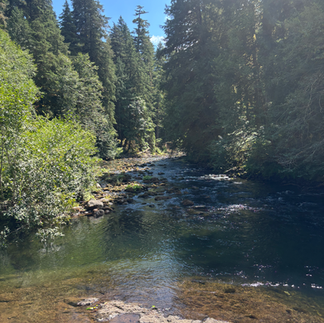The Road to Tor des Geants - Why I'm Pointing Toward the Giants
- Ajay Hanspal

- Aug 25
- 4 min read
Updated: Aug 25
September 14-20, 2025 | Valle d'Aosta, Italy | 350km | 24,000m+ elevation

After completing the Double Paddy Buckley Round and setting FKTs on both sides of the pond, there's one race that keeps pulling at me: Tor des Geants. The 330km (actually 350km) circuit through the Italian Alps with well over 24,000 meters of climbing represents everything I love about ultra running - technical terrain, massive vertical, and the kind of sufferfest that strips away everything but the essentials.
Why TOR?
Simple. It's hard as hell.
I was unable to complete last year's edition due to an ankle injury sustained at the volcanic 50km in the build up to the race, the injury simply didn't heal in time leaving me with unfinished business and a chip on my shoulder. Last year's race threw almost every sort of weather at runners – rain, wind and even snow over three days and three nights, and watching François D'Haene battle through 69 hours of Alpine punishment only reinforced what I already knew: this is the race that separates the committed from the curious.
The course is unforgiving. Starting in Courmayeur, it travels down the mountainous south side of the Aosta Valley, crosses at Donnas, then returns via the equally rugged north side. You're running trails and traversing mountain passes on some of the highest 4,000-meter peaks in the Alps, the 'geants', or giants in english. This isn't a race you stumble into - it demands respect, preparation, and the willingness to dig deeper than you thought possible. On the highly rated Centurion Running podcast, race director and former GB athlete James Elson described the TDG as the hardest conventional race in the world during their race review series (behind only the Barkley Marathons).
The Training Reality
Right now, my training is showing positive trends. Recent sessions have been hitting targets, and more importantly, I'm staying healthy. The ankle issue that has plagued me since August last year has finally resolved. Work and life stress has been affecting nutrition timing, but even with that, my gut tolerance is improving.
The beauty of building toward TOR is that it demands everything I'm already working on:
Volume tolerance: Those 80+ mile & 20+ hr weeks in the mountains aren't optional
Vertical strength: Every hill/mountain session matters when you're looking at 24,000m+
Technical descending: The Double Paddy taught me plenty about managing damage on long descents
Nutrition resilience: How to fuel multi-day efforts in the mountains
The recent stretch of scorching summer days spent grinding out vert in the Mt Hood National Forest, Columbia River Gorge and Tillamook State Forest feels like it’s starting to pay off. This block hasn’t been glamorous, just pure specificity; long climbs and descents, big mountain days, and learning to lean into the grind when the second or third summit of the day feels impossibly and unbearably far away. Out there, yoga, physio, massage, acupuncture, run clubs, muscle guns, recovery boots and other gadgets can’t save you. On the mountain there’s nowhere to hide, you either show up or you don’t. The summit comes only through hard work, meaning the micro-trends and the various marketable trappings that plague running in 2025 are nowhere to be seen. I love that.
Lessons from Recent Races
The Wildwood FKT showed me what happens when you trust your preparation. Eight hours of sustained effort through Oregon's forests, managing pace over technical terrain - that's the non-specific foundational work TOR demands - if you want to be fast in the mountains, you better get fast on the flatter stuff first. Similarly, the Tillamook Burn 50M and those Pacific Northwest adventures have been building the kind of resilience you can't fake.
But it's the Double Paddy that really opened my eyes to what's possible. TOR's 150-hour cutoff seems generous after spending 52+ hours in the Welsh mountains, but the Alps are an entirely different beast. Technical but in a different way, more altitude and greater weather exposure - everything gets amplified or changed here. And to be competitive, a sub 75hr time is needed.
The Path Forward
September 14-20, 2025 gives me the timeline. That's enough runway to continue to build and hone the specific fitness TOR demands while maintaining the consistency that's keeping me healthy. The plan isn't complicated since myself and coach Damian Hall focused on addressing my weaknesses and getting me in exceptional trail running shape all winter and spring, now, specificity is king. This means:
Maintaining weekly volume
Prioritize back-to-back long efforts
Accumulate more technical vertical
Test nutrition strategies under fatigue
Stay healthy (the non-negotiable)
Recent training logs show I'm executing well - hitting distances where I want them, speeds trending up, recovery between sessions solid, body including quads feeling strong and resilient. The foundation is there. Now it's about building the specific adaptations for 350km of Alpine suffering.
Beyond the Suffering
What draws me to TOR isn't just the challenge - it's the purity. Running through Gran Paradiso National Park from the foot of Mont Blanc, over to Monte Rosa, then back to Mont Blanc via the Matterhorn, you're stripped down to the essentials. No hiding behind tactics or conditions. Just you, the mountains, and however much you're willing to give.
That's the conversation I want to have with myself in September 2025. Not whether I trained enough or prepared properly, but whether I was willing to dig deep enough when the mountains asked the question.
The road to TOR 2025 started back in Aug 2024 when I injured my ankle on the slopes of Mt St Helens. Every Lief session, every recovery run along the industrial estate in NW Portland, every bit of elevation worked over the weekends - it all points toward Courmayeur.
Time to find out what I'm made of.
Training continues. Updates to follow as the journey unfolds., a sub 75hr time?























































Comments